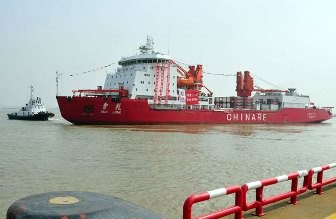China’s team will use for the first time an all-terrain vehicle (ATV) to work in polar conditions as the country’s 32nd Antarctic expedition sets off on Saturday. Nov. 7, the Xinhua News Agency reported.
According to the report, the expedition team received the vehicle, developed by the Polar Research Institute of China and Guizhou Jonyang Kinetics Co. Ltd., in Shanghai on Wednesday, Nov. 4.
Lyu Qian, president of Guizhou Jonyang Kinetics Co. Ltd., said that the amphibious vehicle has outstanding maneuverability and can run in snowfields, beaches, deserts and mountainous regions at a maximum speed of 60 km per hour and 5 km per hour in water.
Lyu added that the ATV can also cross 0.6-meter vertical barriers and 1.5-meter ditches. It can also work in environments between minus 41 degrees Celsius and 40 degrees Celsius. It is also equipped with a low-carbon-emission engine and a computer system that can transmit operation data from the Antarctic back to China for analysis, the report said.
The icebreaker "Xuelong" (Snow Dragon), which has a crew of 265, is expected to leave Shanghai on Saturday, Nov. 7, for the six-month expedition.
The icebreaker will cover about 30,000 nautical miles in the 159-day expedition, the team's deputy chief, Sun Bo, said.
Sun said the team will conduct the final survey for China's fifth Antarctic station site at Victoria Land on the Ross Sea, as well as map the site and carry out ecological and environmental assessments.
China's first fixed-wing aircraft for polar flight will also be tested during the mission around Larsemann Hills, Grove Mountains and China's Kunlun Station in the Antarctic region, while carrying out pilot airborne remote sensing and telemetry tasks.
Team members will conduct comprehensive polar research around the Chinese stations of Changcheng, Zhongshan, Taishan and Kunlun, as well as in areas including Prydz Bay, Ross Sea, Amundsen Sea and the Antarctic Peninsula.



























